Leadership Report: Styles, Qualities, Importance, and Management
VerifiedAdded on 2022/12/16
|9
|1904
|97
Report
AI Summary
This report provides a comprehensive overview of leadership, exploring its fundamental meaning and significance in organizational settings. It delves into the essential qualities required to become an effective leader, highlighting characteristics such as influencing power, problem-solving abilities, motivational skills, and the ability to delegate work. The report examines various leadership styles, including autocratic, democratic, laissez-faire, and coach styles, analyzing their respective advantages and disadvantages. It emphasizes the importance of leadership in providing motivation, building confidence among employees, fostering coordination, and initiating action within a team. Furthermore, the report distinguishes between leadership and management, clarifying their distinct roles and responsibilities. The report concludes by summarizing the crucial role of leadership in guiding and managing staff towards achieving organizational goals.
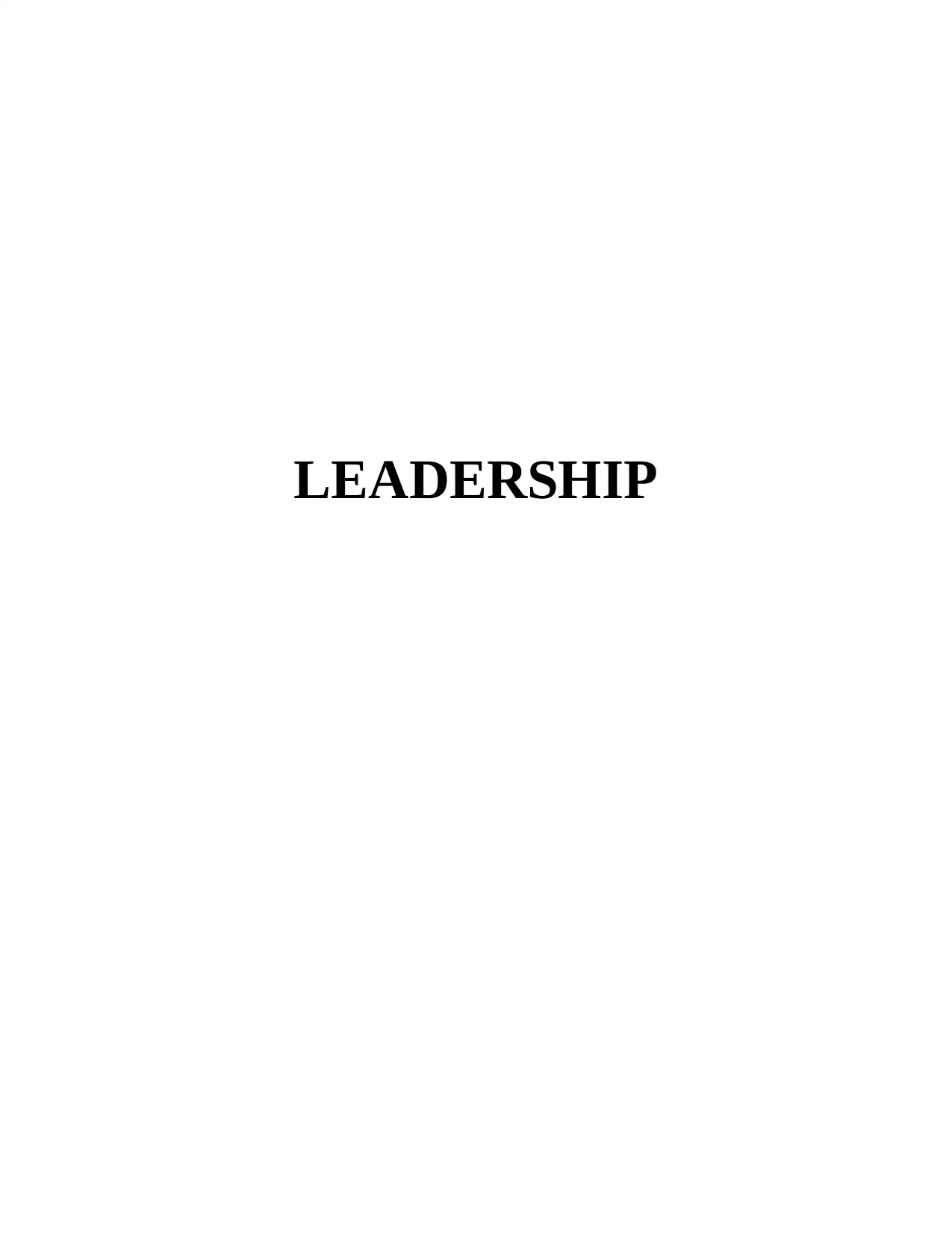
LEADERSHIP
Paraphrase This Document
Need a fresh take? Get an instant paraphrase of this document with our AI Paraphraser
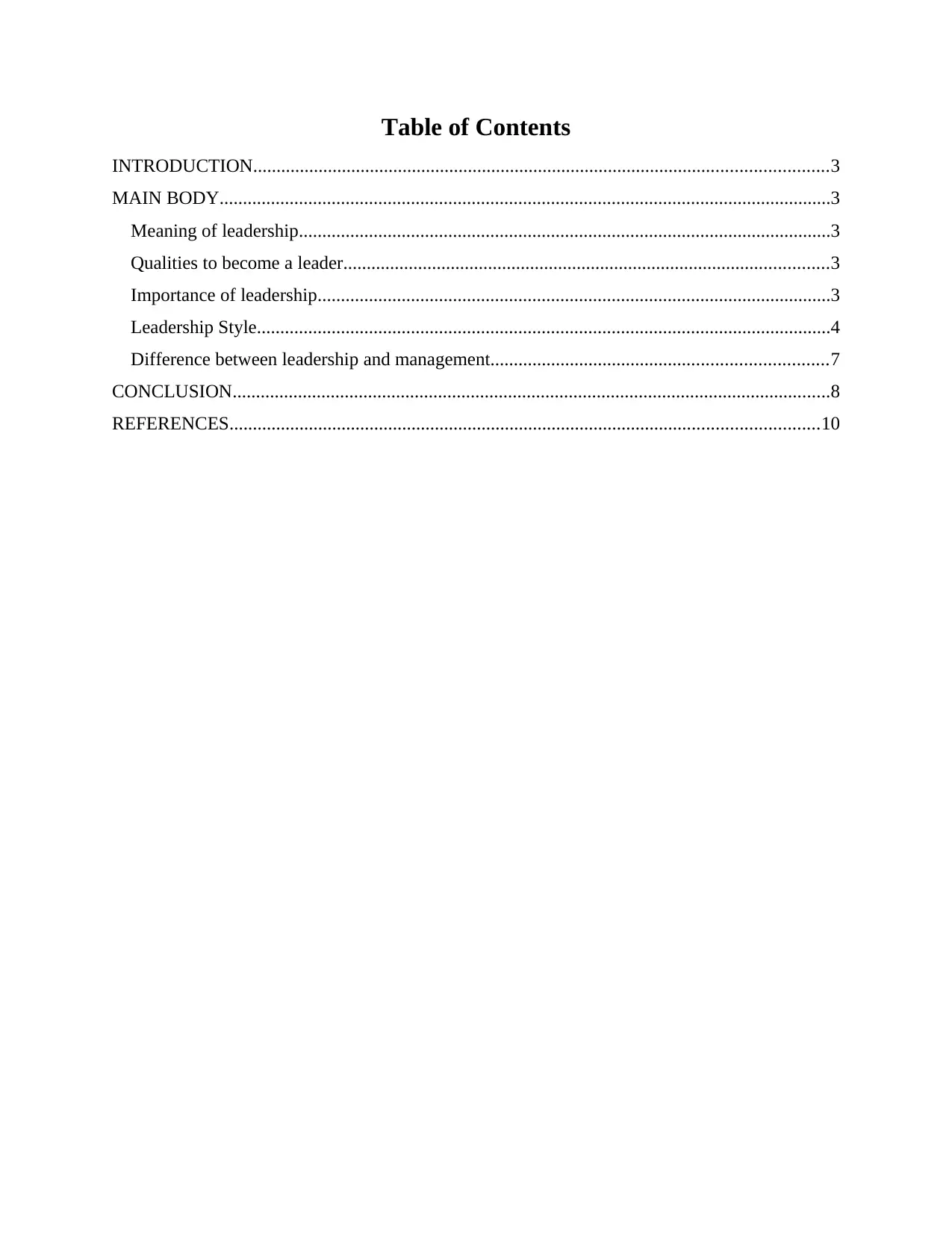
Table of Contents
INTRODUCTION...........................................................................................................................3
MAIN BODY...................................................................................................................................3
Meaning of leadership..................................................................................................................3
Qualities to become a leader........................................................................................................3
Importance of leadership..............................................................................................................3
Leadership Style...........................................................................................................................4
Difference between leadership and management........................................................................7
CONCLUSION................................................................................................................................8
REFERENCES..............................................................................................................................10
INTRODUCTION...........................................................................................................................3
MAIN BODY...................................................................................................................................3
Meaning of leadership..................................................................................................................3
Qualities to become a leader........................................................................................................3
Importance of leadership..............................................................................................................3
Leadership Style...........................................................................................................................4
Difference between leadership and management........................................................................7
CONCLUSION................................................................................................................................8
REFERENCES..............................................................................................................................10
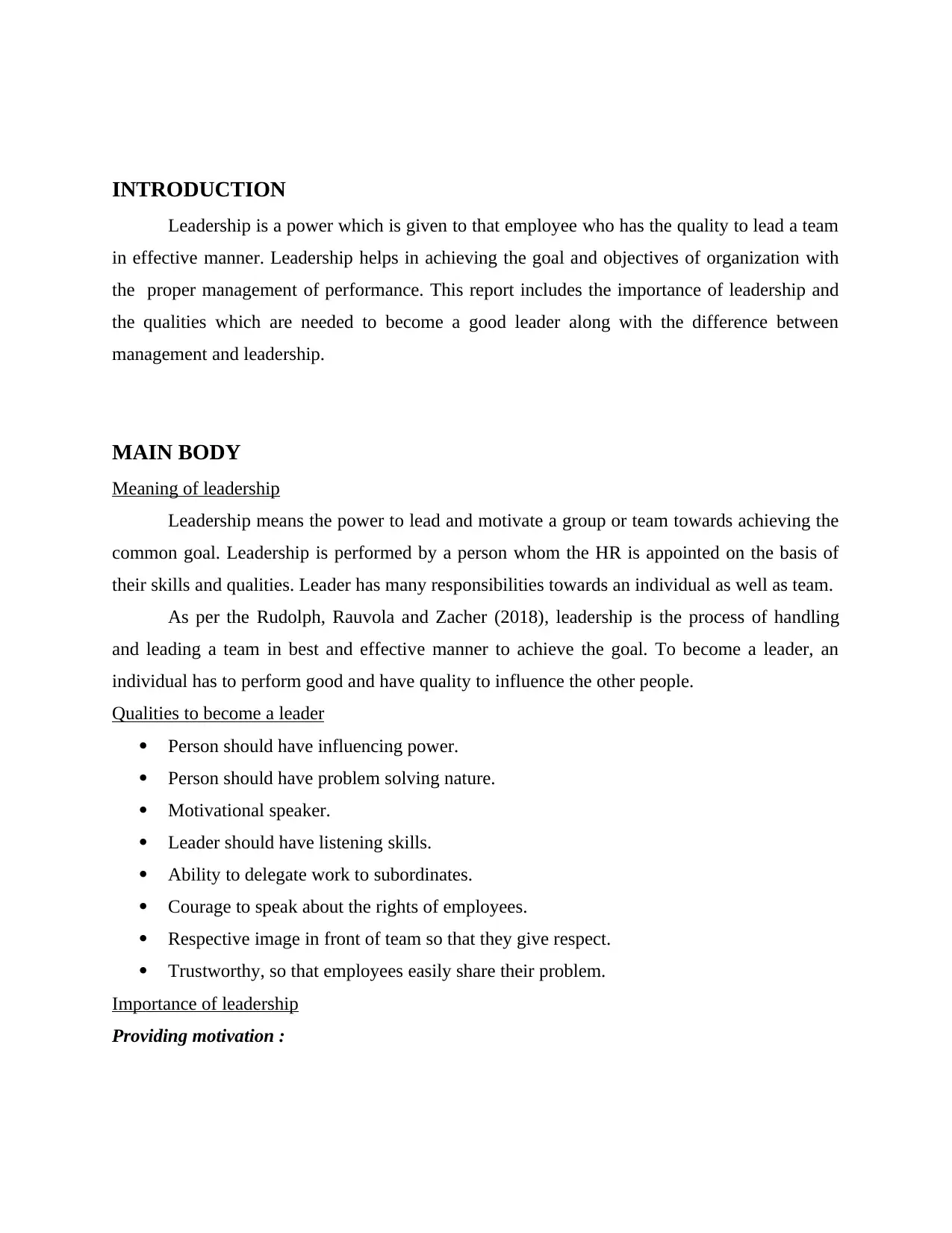
INTRODUCTION
Leadership is a power which is given to that employee who has the quality to lead a team
in effective manner. Leadership helps in achieving the goal and objectives of organization with
the proper management of performance. This report includes the importance of leadership and
the qualities which are needed to become a good leader along with the difference between
management and leadership.
MAIN BODY
Meaning of leadership
Leadership means the power to lead and motivate a group or team towards achieving the
common goal. Leadership is performed by a person whom the HR is appointed on the basis of
their skills and qualities. Leader has many responsibilities towards an individual as well as team.
As per the Rudolph, Rauvola and Zacher (2018), leadership is the process of handling
and leading a team in best and effective manner to achieve the goal. To become a leader, an
individual has to perform good and have quality to influence the other people.
Qualities to become a leader
Person should have influencing power.
Person should have problem solving nature.
Motivational speaker.
Leader should have listening skills.
Ability to delegate work to subordinates.
Courage to speak about the rights of employees.
Respective image in front of team so that they give respect.
Trustworthy, so that employees easily share their problem.
Importance of leadership
Providing motivation :
Leadership is a power which is given to that employee who has the quality to lead a team
in effective manner. Leadership helps in achieving the goal and objectives of organization with
the proper management of performance. This report includes the importance of leadership and
the qualities which are needed to become a good leader along with the difference between
management and leadership.
MAIN BODY
Meaning of leadership
Leadership means the power to lead and motivate a group or team towards achieving the
common goal. Leadership is performed by a person whom the HR is appointed on the basis of
their skills and qualities. Leader has many responsibilities towards an individual as well as team.
As per the Rudolph, Rauvola and Zacher (2018), leadership is the process of handling
and leading a team in best and effective manner to achieve the goal. To become a leader, an
individual has to perform good and have quality to influence the other people.
Qualities to become a leader
Person should have influencing power.
Person should have problem solving nature.
Motivational speaker.
Leader should have listening skills.
Ability to delegate work to subordinates.
Courage to speak about the rights of employees.
Respective image in front of team so that they give respect.
Trustworthy, so that employees easily share their problem.
Importance of leadership
Providing motivation :
⊘ This is a preview!⊘
Do you want full access?
Subscribe today to unlock all pages.

Trusted by 1+ million students worldwide
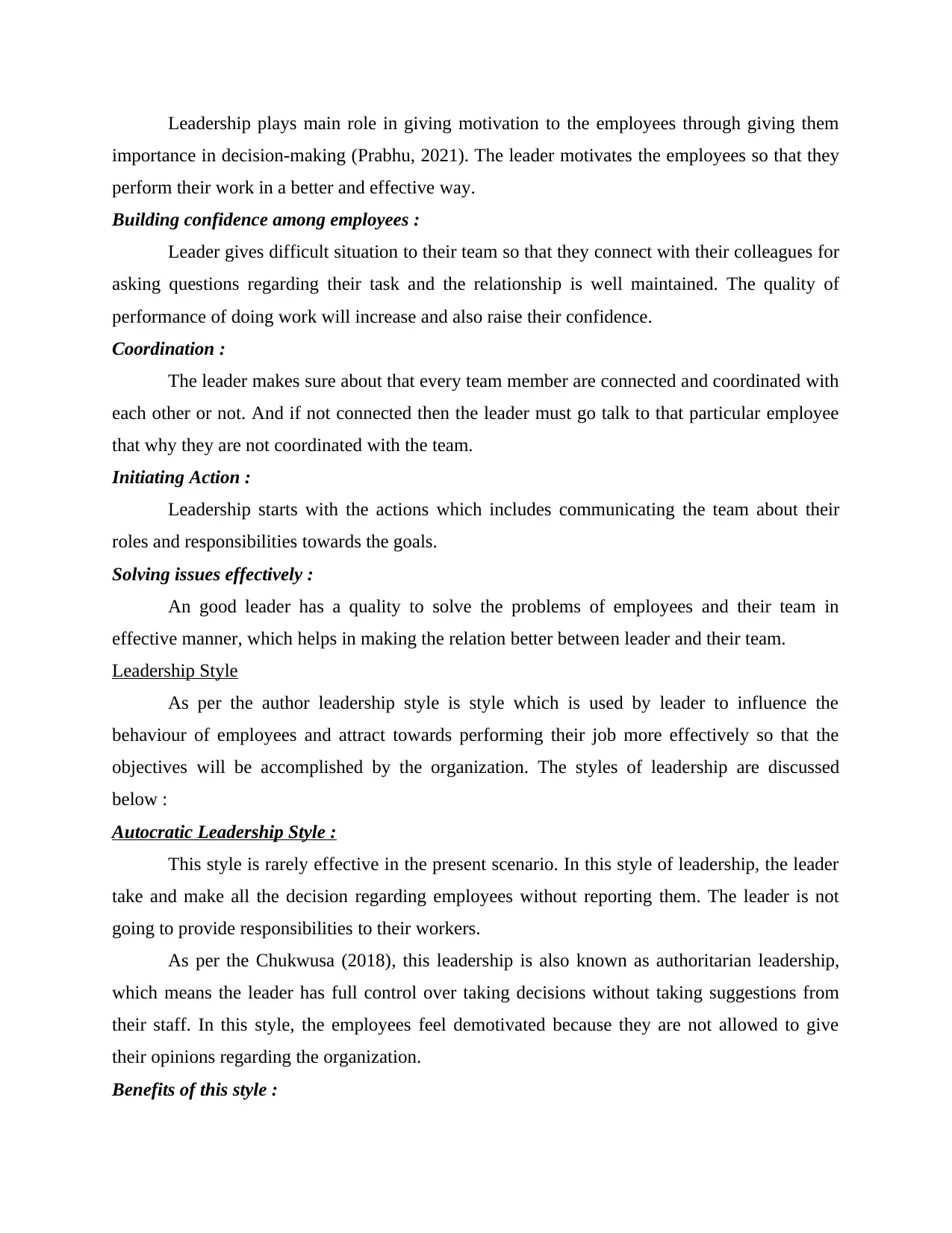
Leadership plays main role in giving motivation to the employees through giving them
importance in decision-making (Prabhu, 2021). The leader motivates the employees so that they
perform their work in a better and effective way.
Building confidence among employees :
Leader gives difficult situation to their team so that they connect with their colleagues for
asking questions regarding their task and the relationship is well maintained. The quality of
performance of doing work will increase and also raise their confidence.
Coordination :
The leader makes sure about that every team member are connected and coordinated with
each other or not. And if not connected then the leader must go talk to that particular employee
that why they are not coordinated with the team.
Initiating Action :
Leadership starts with the actions which includes communicating the team about their
roles and responsibilities towards the goals.
Solving issues effectively :
An good leader has a quality to solve the problems of employees and their team in
effective manner, which helps in making the relation better between leader and their team.
Leadership Style
As per the author leadership style is style which is used by leader to influence the
behaviour of employees and attract towards performing their job more effectively so that the
objectives will be accomplished by the organization. The styles of leadership are discussed
below :
Autocratic Leadership Style :
This style is rarely effective in the present scenario. In this style of leadership, the leader
take and make all the decision regarding employees without reporting them. The leader is not
going to provide responsibilities to their workers.
As per the Chukwusa (2018), this leadership is also known as authoritarian leadership,
which means the leader has full control over taking decisions without taking suggestions from
their staff. In this style, the employees feel demotivated because they are not allowed to give
their opinions regarding the organization.
Benefits of this style :
importance in decision-making (Prabhu, 2021). The leader motivates the employees so that they
perform their work in a better and effective way.
Building confidence among employees :
Leader gives difficult situation to their team so that they connect with their colleagues for
asking questions regarding their task and the relationship is well maintained. The quality of
performance of doing work will increase and also raise their confidence.
Coordination :
The leader makes sure about that every team member are connected and coordinated with
each other or not. And if not connected then the leader must go talk to that particular employee
that why they are not coordinated with the team.
Initiating Action :
Leadership starts with the actions which includes communicating the team about their
roles and responsibilities towards the goals.
Solving issues effectively :
An good leader has a quality to solve the problems of employees and their team in
effective manner, which helps in making the relation better between leader and their team.
Leadership Style
As per the author leadership style is style which is used by leader to influence the
behaviour of employees and attract towards performing their job more effectively so that the
objectives will be accomplished by the organization. The styles of leadership are discussed
below :
Autocratic Leadership Style :
This style is rarely effective in the present scenario. In this style of leadership, the leader
take and make all the decision regarding employees without reporting them. The leader is not
going to provide responsibilities to their workers.
As per the Chukwusa (2018), this leadership is also known as authoritarian leadership,
which means the leader has full control over taking decisions without taking suggestions from
their staff. In this style, the employees feel demotivated because they are not allowed to give
their opinions regarding the organization.
Benefits of this style :
Paraphrase This Document
Need a fresh take? Get an instant paraphrase of this document with our AI Paraphraser
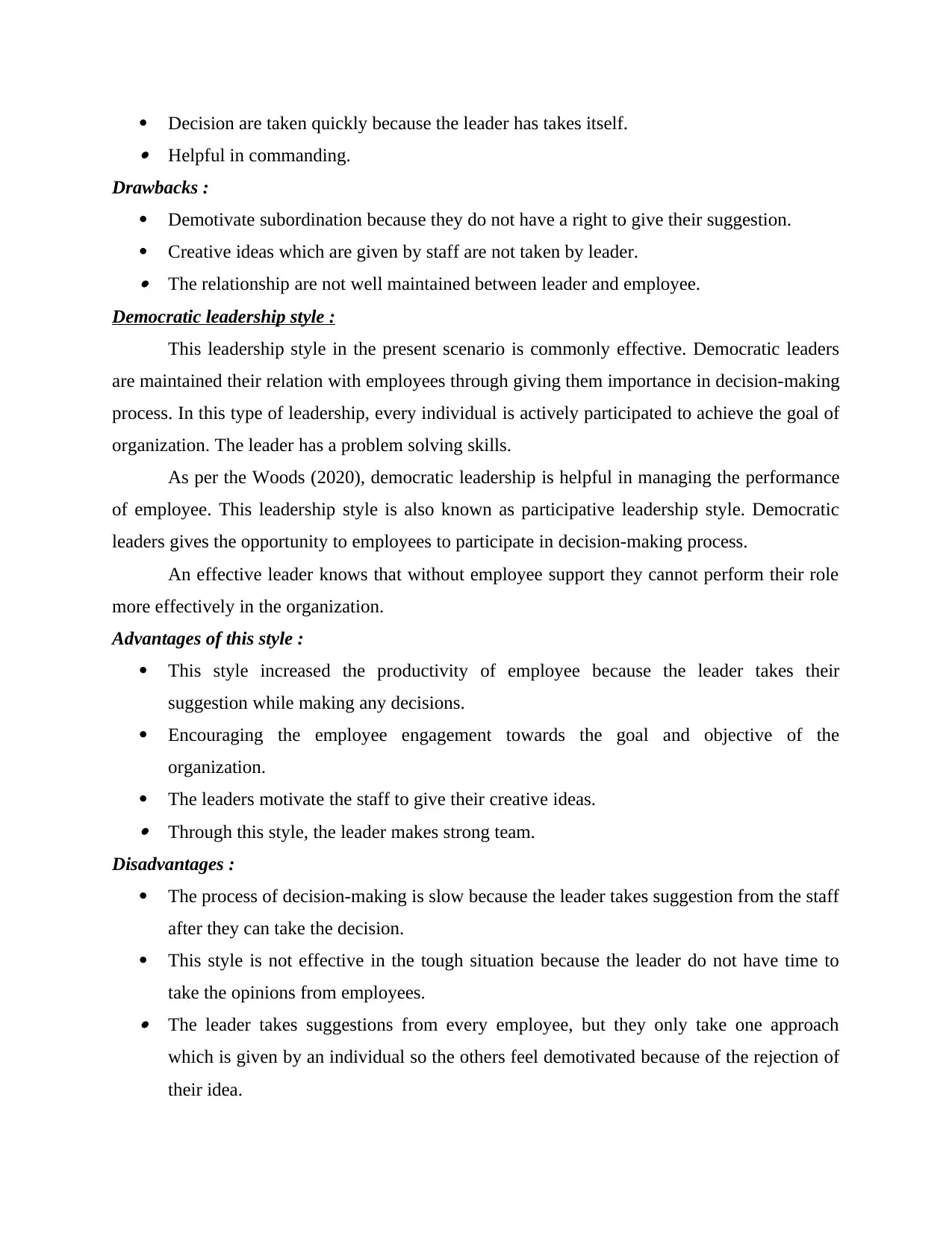
Decision are taken quickly because the leader has takes itself. Helpful in commanding.
Drawbacks :
Demotivate subordination because they do not have a right to give their suggestion.
Creative ideas which are given by staff are not taken by leader. The relationship are not well maintained between leader and employee.
Democratic leadership style :
This leadership style in the present scenario is commonly effective. Democratic leaders
are maintained their relation with employees through giving them importance in decision-making
process. In this type of leadership, every individual is actively participated to achieve the goal of
organization. The leader has a problem solving skills.
As per the Woods (2020), democratic leadership is helpful in managing the performance
of employee. This leadership style is also known as participative leadership style. Democratic
leaders gives the opportunity to employees to participate in decision-making process.
An effective leader knows that without employee support they cannot perform their role
more effectively in the organization.
Advantages of this style :
This style increased the productivity of employee because the leader takes their
suggestion while making any decisions.
Encouraging the employee engagement towards the goal and objective of the
organization.
The leaders motivate the staff to give their creative ideas. Through this style, the leader makes strong team.
Disadvantages :
The process of decision-making is slow because the leader takes suggestion from the staff
after they can take the decision.
This style is not effective in the tough situation because the leader do not have time to
take the opinions from employees. The leader takes suggestions from every employee, but they only take one approach
which is given by an individual so the others feel demotivated because of the rejection of
their idea.
Drawbacks :
Demotivate subordination because they do not have a right to give their suggestion.
Creative ideas which are given by staff are not taken by leader. The relationship are not well maintained between leader and employee.
Democratic leadership style :
This leadership style in the present scenario is commonly effective. Democratic leaders
are maintained their relation with employees through giving them importance in decision-making
process. In this type of leadership, every individual is actively participated to achieve the goal of
organization. The leader has a problem solving skills.
As per the Woods (2020), democratic leadership is helpful in managing the performance
of employee. This leadership style is also known as participative leadership style. Democratic
leaders gives the opportunity to employees to participate in decision-making process.
An effective leader knows that without employee support they cannot perform their role
more effectively in the organization.
Advantages of this style :
This style increased the productivity of employee because the leader takes their
suggestion while making any decisions.
Encouraging the employee engagement towards the goal and objective of the
organization.
The leaders motivate the staff to give their creative ideas. Through this style, the leader makes strong team.
Disadvantages :
The process of decision-making is slow because the leader takes suggestion from the staff
after they can take the decision.
This style is not effective in the tough situation because the leader do not have time to
take the opinions from employees. The leader takes suggestions from every employee, but they only take one approach
which is given by an individual so the others feel demotivated because of the rejection of
their idea.
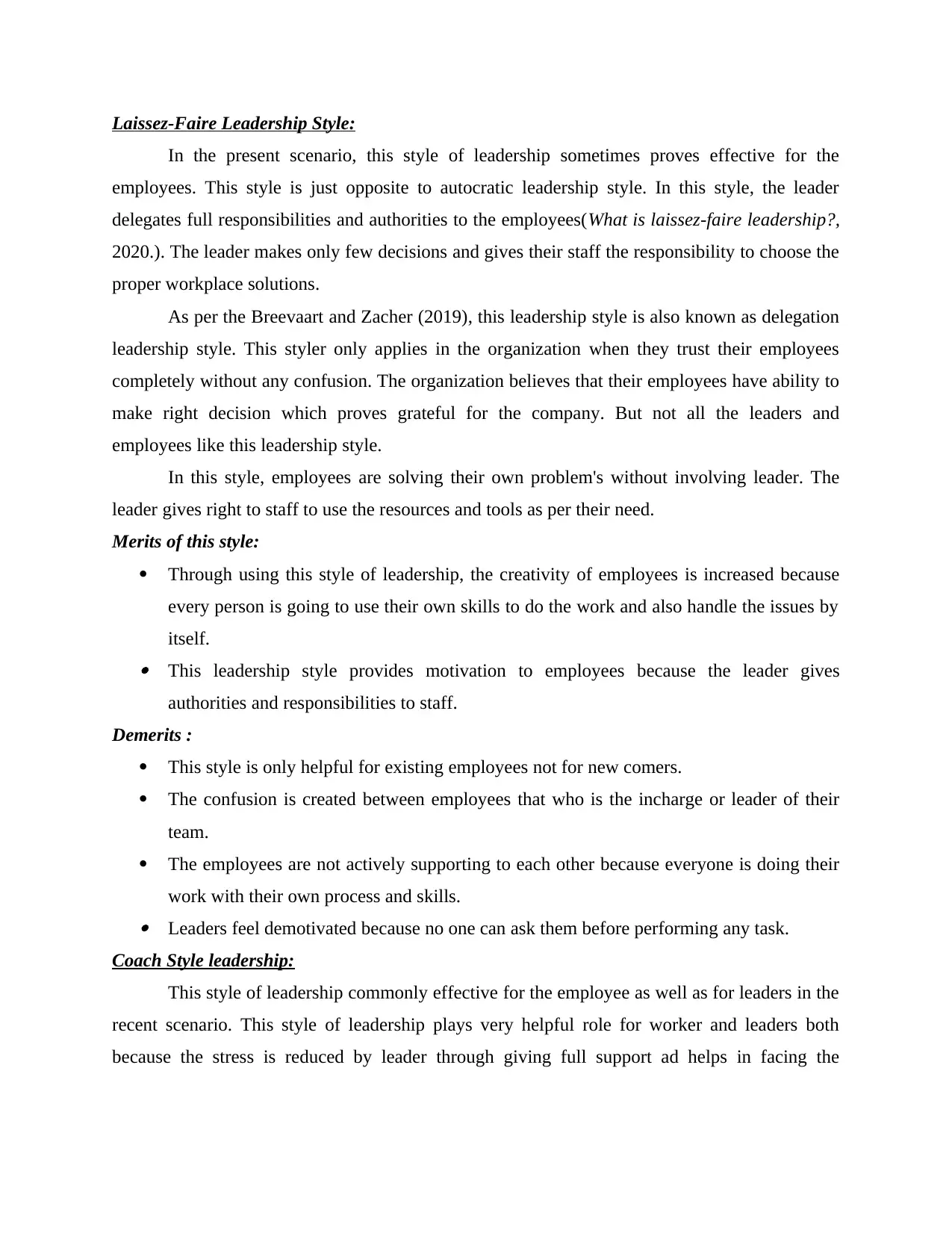
Laissez-Faire Leadership Style:
In the present scenario, this style of leadership sometimes proves effective for the
employees. This style is just opposite to autocratic leadership style. In this style, the leader
delegates full responsibilities and authorities to the employees(What is laissez-faire leadership?,
2020.). The leader makes only few decisions and gives their staff the responsibility to choose the
proper workplace solutions.
As per the Breevaart and Zacher (2019), this leadership style is also known as delegation
leadership style. This styler only applies in the organization when they trust their employees
completely without any confusion. The organization believes that their employees have ability to
make right decision which proves grateful for the company. But not all the leaders and
employees like this leadership style.
In this style, employees are solving their own problem's without involving leader. The
leader gives right to staff to use the resources and tools as per their need.
Merits of this style:
Through using this style of leadership, the creativity of employees is increased because
every person is going to use their own skills to do the work and also handle the issues by
itself. This leadership style provides motivation to employees because the leader gives
authorities and responsibilities to staff.
Demerits :
This style is only helpful for existing employees not for new comers.
The confusion is created between employees that who is the incharge or leader of their
team.
The employees are not actively supporting to each other because everyone is doing their
work with their own process and skills. Leaders feel demotivated because no one can ask them before performing any task.
Coach Style leadership:
This style of leadership commonly effective for the employee as well as for leaders in the
recent scenario. This style of leadership plays very helpful role for worker and leaders both
because the stress is reduced by leader through giving full support ad helps in facing the
In the present scenario, this style of leadership sometimes proves effective for the
employees. This style is just opposite to autocratic leadership style. In this style, the leader
delegates full responsibilities and authorities to the employees(What is laissez-faire leadership?,
2020.). The leader makes only few decisions and gives their staff the responsibility to choose the
proper workplace solutions.
As per the Breevaart and Zacher (2019), this leadership style is also known as delegation
leadership style. This styler only applies in the organization when they trust their employees
completely without any confusion. The organization believes that their employees have ability to
make right decision which proves grateful for the company. But not all the leaders and
employees like this leadership style.
In this style, employees are solving their own problem's without involving leader. The
leader gives right to staff to use the resources and tools as per their need.
Merits of this style:
Through using this style of leadership, the creativity of employees is increased because
every person is going to use their own skills to do the work and also handle the issues by
itself. This leadership style provides motivation to employees because the leader gives
authorities and responsibilities to staff.
Demerits :
This style is only helpful for existing employees not for new comers.
The confusion is created between employees that who is the incharge or leader of their
team.
The employees are not actively supporting to each other because everyone is doing their
work with their own process and skills. Leaders feel demotivated because no one can ask them before performing any task.
Coach Style leadership:
This style of leadership commonly effective for the employee as well as for leaders in the
recent scenario. This style of leadership plays very helpful role for worker and leaders both
because the stress is reduced by leader through giving full support ad helps in facing the
⊘ This is a preview!⊘
Do you want full access?
Subscribe today to unlock all pages.

Trusted by 1+ million students worldwide
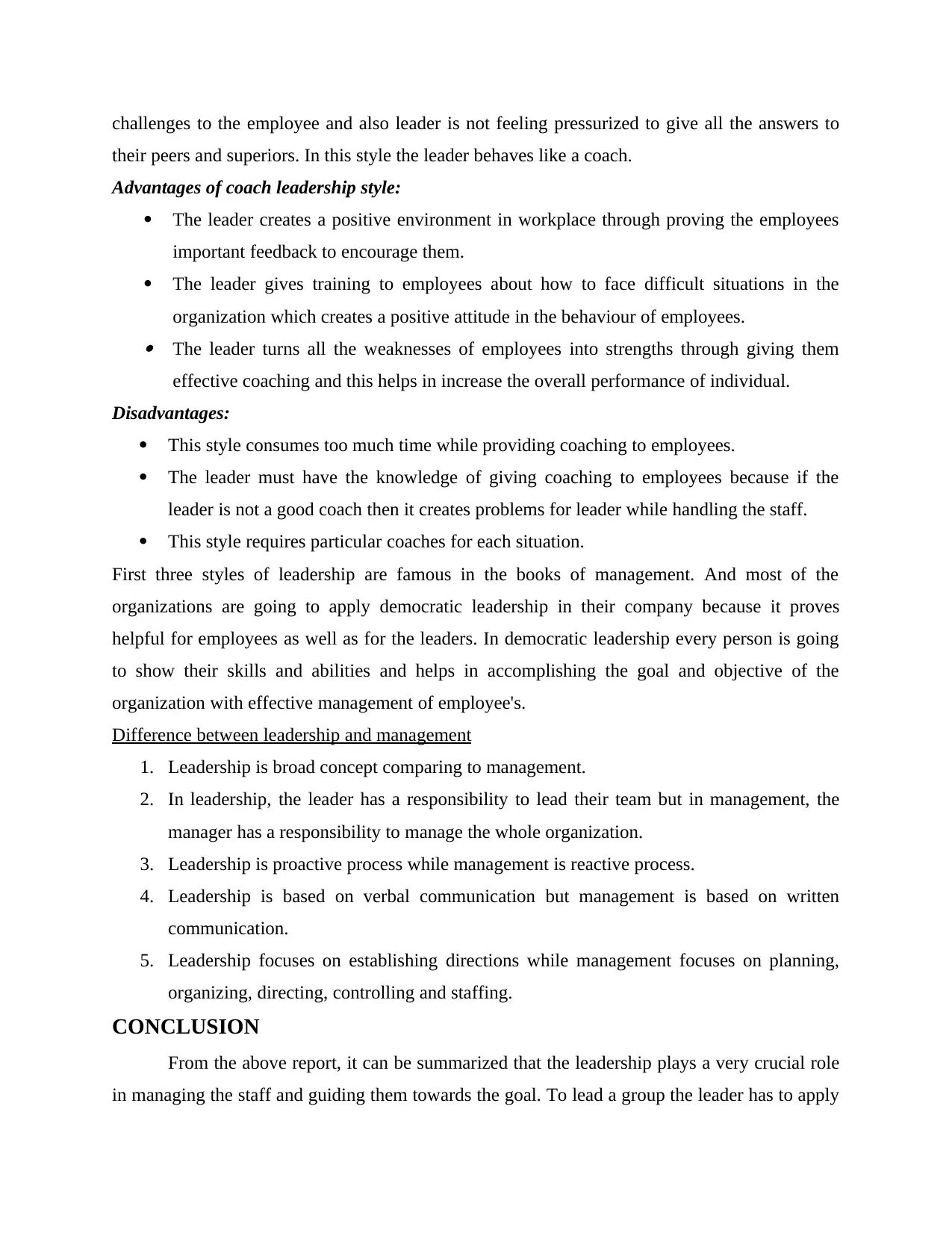
challenges to the employee and also leader is not feeling pressurized to give all the answers to
their peers and superiors. In this style the leader behaves like a coach.
Advantages of coach leadership style:
The leader creates a positive environment in workplace through proving the employees
important feedback to encourage them.
The leader gives training to employees about how to face difficult situations in the
organization which creates a positive attitude in the behaviour of employees. The leader turns all the weaknesses of employees into strengths through giving them
effective coaching and this helps in increase the overall performance of individual.
Disadvantages:
This style consumes too much time while providing coaching to employees.
The leader must have the knowledge of giving coaching to employees because if the
leader is not a good coach then it creates problems for leader while handling the staff.
This style requires particular coaches for each situation.
First three styles of leadership are famous in the books of management. And most of the
organizations are going to apply democratic leadership in their company because it proves
helpful for employees as well as for the leaders. In democratic leadership every person is going
to show their skills and abilities and helps in accomplishing the goal and objective of the
organization with effective management of employee's.
Difference between leadership and management
1. Leadership is broad concept comparing to management.
2. In leadership, the leader has a responsibility to lead their team but in management, the
manager has a responsibility to manage the whole organization.
3. Leadership is proactive process while management is reactive process.
4. Leadership is based on verbal communication but management is based on written
communication.
5. Leadership focuses on establishing directions while management focuses on planning,
organizing, directing, controlling and staffing.
CONCLUSION
From the above report, it can be summarized that the leadership plays a very crucial role
in managing the staff and guiding them towards the goal. To lead a group the leader has to apply
their peers and superiors. In this style the leader behaves like a coach.
Advantages of coach leadership style:
The leader creates a positive environment in workplace through proving the employees
important feedback to encourage them.
The leader gives training to employees about how to face difficult situations in the
organization which creates a positive attitude in the behaviour of employees. The leader turns all the weaknesses of employees into strengths through giving them
effective coaching and this helps in increase the overall performance of individual.
Disadvantages:
This style consumes too much time while providing coaching to employees.
The leader must have the knowledge of giving coaching to employees because if the
leader is not a good coach then it creates problems for leader while handling the staff.
This style requires particular coaches for each situation.
First three styles of leadership are famous in the books of management. And most of the
organizations are going to apply democratic leadership in their company because it proves
helpful for employees as well as for the leaders. In democratic leadership every person is going
to show their skills and abilities and helps in accomplishing the goal and objective of the
organization with effective management of employee's.
Difference between leadership and management
1. Leadership is broad concept comparing to management.
2. In leadership, the leader has a responsibility to lead their team but in management, the
manager has a responsibility to manage the whole organization.
3. Leadership is proactive process while management is reactive process.
4. Leadership is based on verbal communication but management is based on written
communication.
5. Leadership focuses on establishing directions while management focuses on planning,
organizing, directing, controlling and staffing.
CONCLUSION
From the above report, it can be summarized that the leadership plays a very crucial role
in managing the staff and guiding them towards the goal. To lead a group the leader has to apply
Paraphrase This Document
Need a fresh take? Get an instant paraphrase of this document with our AI Paraphraser
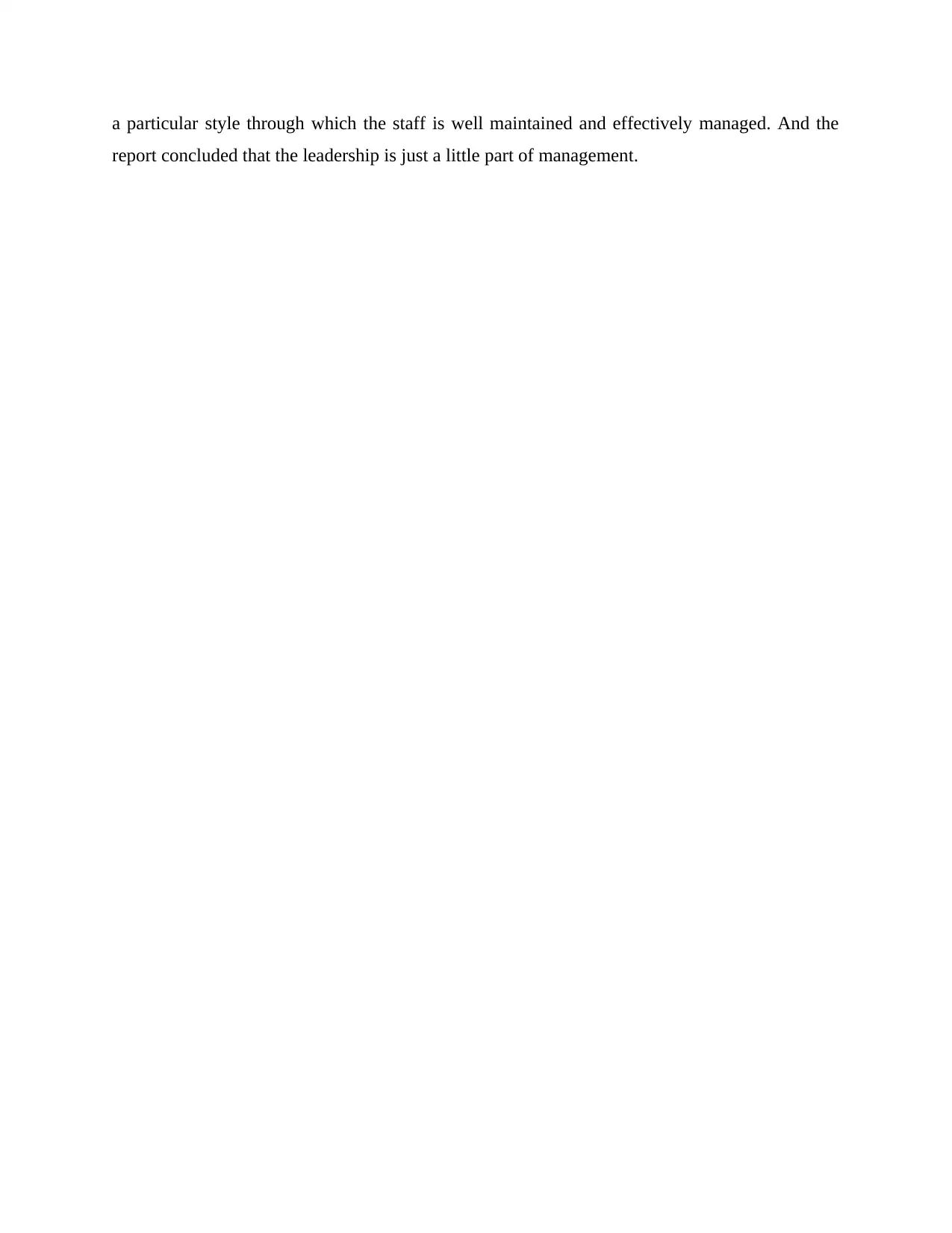
a particular style through which the staff is well maintained and effectively managed. And the
report concluded that the leadership is just a little part of management.
report concluded that the leadership is just a little part of management.
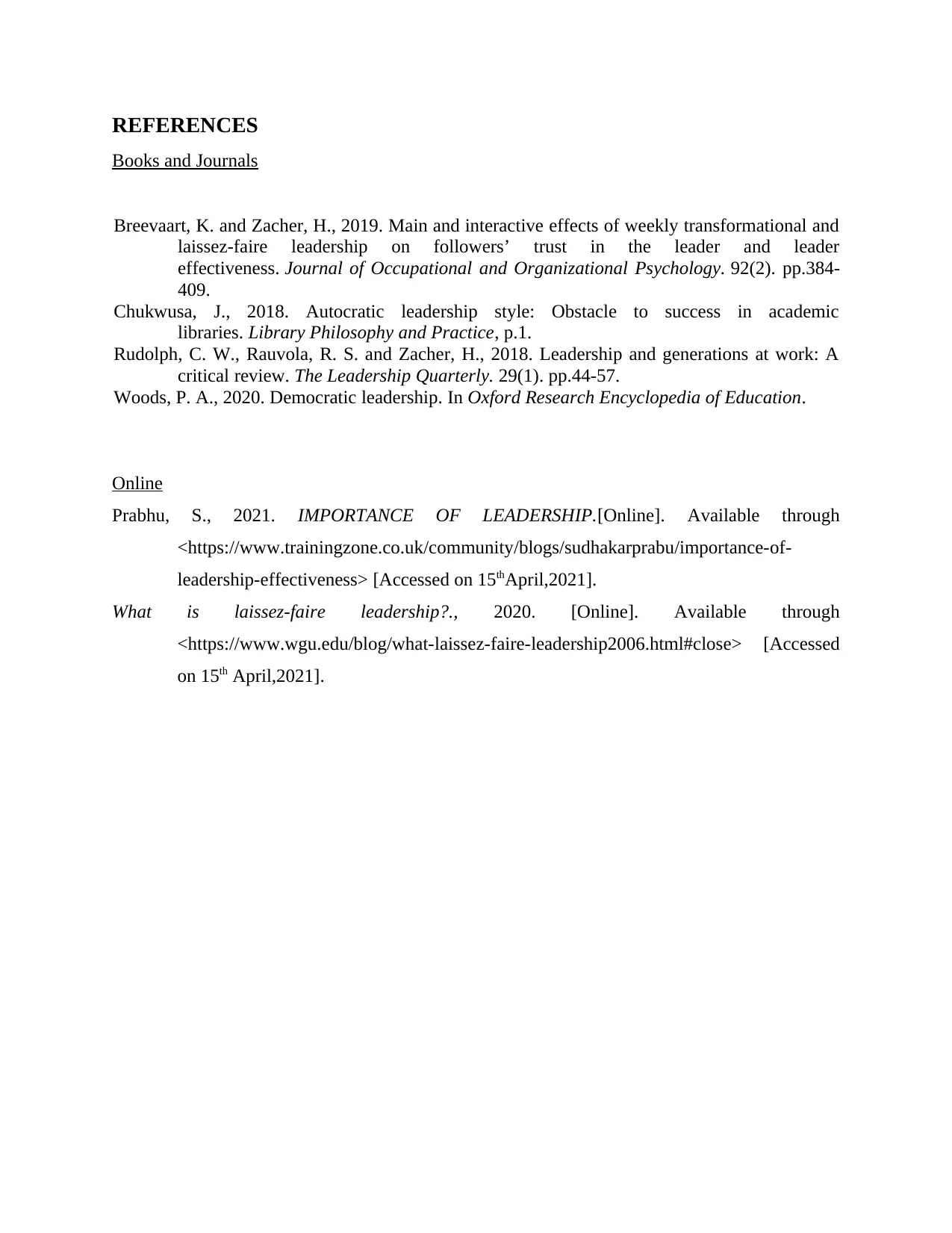
REFERENCES
Books and Journals
Breevaart, K. and Zacher, H., 2019. Main and interactive effects of weekly transformational and
laissez‐faire leadership on followers’ trust in the leader and leader
effectiveness. Journal of Occupational and Organizational Psychology. 92(2). pp.384-
409.
Chukwusa, J., 2018. Autocratic leadership style: Obstacle to success in academic
libraries. Library Philosophy and Practice, p.1.
Rudolph, C. W., Rauvola, R. S. and Zacher, H., 2018. Leadership and generations at work: A
critical review. The Leadership Quarterly. 29(1). pp.44-57.
Woods, P. A., 2020. Democratic leadership. In Oxford Research Encyclopedia of Education.
Online
Prabhu, S., 2021. IMPORTANCE OF LEADERSHIP.[Online]. Available through
<https://www.trainingzone.co.uk/community/blogs/sudhakarprabu/importance-of-
leadership-effectiveness> [Accessed on 15thApril,2021].
What is laissez-faire leadership?., 2020. [Online]. Available through
<https://www.wgu.edu/blog/what-laissez-faire-leadership2006.html#close> [Accessed
on 15th April,2021].
Books and Journals
Breevaart, K. and Zacher, H., 2019. Main and interactive effects of weekly transformational and
laissez‐faire leadership on followers’ trust in the leader and leader
effectiveness. Journal of Occupational and Organizational Psychology. 92(2). pp.384-
409.
Chukwusa, J., 2018. Autocratic leadership style: Obstacle to success in academic
libraries. Library Philosophy and Practice, p.1.
Rudolph, C. W., Rauvola, R. S. and Zacher, H., 2018. Leadership and generations at work: A
critical review. The Leadership Quarterly. 29(1). pp.44-57.
Woods, P. A., 2020. Democratic leadership. In Oxford Research Encyclopedia of Education.
Online
Prabhu, S., 2021. IMPORTANCE OF LEADERSHIP.[Online]. Available through
<https://www.trainingzone.co.uk/community/blogs/sudhakarprabu/importance-of-
leadership-effectiveness> [Accessed on 15thApril,2021].
What is laissez-faire leadership?., 2020. [Online]. Available through
<https://www.wgu.edu/blog/what-laissez-faire-leadership2006.html#close> [Accessed
on 15th April,2021].
⊘ This is a preview!⊘
Do you want full access?
Subscribe today to unlock all pages.

Trusted by 1+ million students worldwide
1 out of 9
Related Documents
Your All-in-One AI-Powered Toolkit for Academic Success.
+13062052269
info@desklib.com
Available 24*7 on WhatsApp / Email
![[object Object]](/_next/static/media/star-bottom.7253800d.svg)
Unlock your academic potential
Copyright © 2020–2025 A2Z Services. All Rights Reserved. Developed and managed by ZUCOL.





